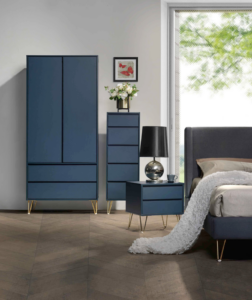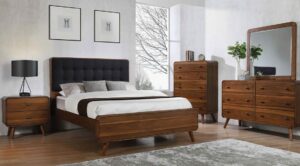In 2020, Covid changed the way Americans live and work in their homes. During the pandemic, 76% of people made some kind of improvement to their home. (Statista) Nesting was a popular trend. Despite supply chain disruptions, many families purchased new furniture and home accessories to make their environments more comfortable. Companies had to quickly implement remote work arrangements to ensure business continuity and the number of people working from home skyrocketed. According to some estimates, the number of people working from home increased by over 50%. Many of those new remote workers purchased furniture to accommodate the change. Accelerated in large part due to the pandemic, the US furniture market is now worth more than $68B annually. Popular trends such as eco-friendly and ready-to-assemble (RTA) furniture continue to drive growth.
Today, the most successful furniture retailers are those who are ready to meet consumers where they are and accompany them on a path to purchase that wanders back and forth from online to in-store. That means that the old days of single-stream customer acquisition are over. It’s not enough to advertise in the local newspaper. To attract and engage new customers, retailers must leverage both analog and digital tools in the omnichannel environment that modern shoppers expect and demand.
The Appeal of the In-Store Visit
Creating an inviting and appealing in-store experience can have a significant impact on retail furniture sales. According to a study by the National Retail Federation, 69% of consumers are more likely to make a purchase if they can count on a consistently enjoyable in-store experience. This means that retailers who invest in creating a comfortable and visually appealing environment are more likely to attract and retain customers, resulting in increased sales. By creating a welcoming environment, retailers can differentiate themselves from online shopping options and increase foot traffic, ultimately leading to higher sales. To make your store more appealing, consider some of the following suggestions:
- Leverage website data to create in-store displays that show off the inventory that you know is most enticing to shoppers.
- Train staff in using online data such as the information gathered by STylLeads by Shoptelligence to maximize the in-store experience.
- Provide comfortable seating areas
- Play popular music at a level that is loud enough to be audible, but quiet enough to prevent interfering with conversation.
- Offer refreshments and other perks that make your store a family-friendly destination.
Boost SEO and Search Rankings by Improving Your Website
Appearing at the top of search engine result pages (SERPs) is critical, as most consumers (87%) begin their shopping journey online. This means that a store’s visibility in search engine results is directly linked to its online presence and overall sales. By appearing at the top of SERPs, furniture stores can increase their visibility and credibility, ultimately leading to increased online traffic and sales. Improve your rankings by optimizing your website for search engines, and adding targeted keywords to boost SEO (search engine optimization). Nearly three-quarters of online shoppers report that their perception of a business’s website influences their decision to purchase. Maximize the appeal of your website by improving visual appeal with 360-degree videos and other interactive tools, ensuring easy navigation, and providing effective filters to help visitors find just what they’re searching for.
Improve Your Social Media Presence
Social media platforms such as Facebook, Instagram, Pinterest, and TikTok are powerful tools for furniture retailers, allowing them to connect with their audience, showcase their products, build their brand, and promote their products through targeted advertising. By leveraging social media, furniture retailers can create brand awareness, generate leads, and drive traffic to their website by posting high-quality images and videos, engaging with customers, and partnering with influencers to promote their products. Try these three suggestions to see fast results:
- Showcase High-Quality Images: Consumers are more likely to engage with content that is visually appealing, and high-quality images can help furniture retailers stand out on social media platforms. Use professional photography or carefully curated user-generated content.
- Engage with Customers: It is crucial to respond promptly to comments, direct messages, and reviews, to build relationships with customers and address their questions and concerns.
- Run Targeted Advertising Campaigns: Social media platforms offer powerful targeting capabilities that allow retailers to reach their ideal customers based on demographics, interests, and behaviors. By targeting ads to specific audiences, you can increase the effectiveness of your advertising campaigns and generate more leads and sales.
Take Advantage of Review Sites
Review sites such as Yelp, Google Reviews, or Trustpilot can have a significant impact on furniture retailers. Unfortunately, that impact can be both very helpful and extremely destructive. On one hand, positive reviews can help build trust and credibility with potential customers, which can lead to increased sales. Positive reviews can also enhance a retailer’s online reputation, which can help them stand out from competitors and attract more customers. Retailers can also leverage positive reviews by sharing them on their website and social media channels, creating opportunities for social proof and unpaid marketing.
On the other hand, negative reviews can hurt furniture retailers by damaging their reputation and discouraging potential customers from making a purchase. Negative reviews can also impact a retailer’s search engine ranking and make it more difficult for them to attract new customers. It’s critical for furniture retailers to monitor their reviews and respond to both positive and negative feedback. By addressing negative feedback and resolving customer complaints, retailers can demonstrate that they care about their customers and are committed to providing a positive shopping experience.
Leverage Direct Email Communications
Email communication remains a valuable tool for furniture retailers, even in today’s fast-paced marketing environment. It allows vendors to directly reach a targeted audience with personalized communication, reaching new shoppers while cultivating long-term relationships with existing customers.
“By combining personalized communications with an intelligent understanding of a consumer’s preferences and needs, you can maximize response rate and boost revenue-per-subscriber, all while building customer loyalty.” -Manal Ilayan, VP of Sales & Marketing
Furniture retailers can maximize the value of email marketing by using a variety of tactics to reach their audience and increase engagement. One important strategy is segmentation, which involves dividing an email list into smaller groups based on specific criteria, such as demographics, purchase history, or website behavior. You can leverage segmented lists to deliver targeted content and promotions that are more relevant to each subscriber’s interests and needs.
Personalization is another key tactic. Generate subject lines, content, and product recommendations based on what you’ve learned about a shopper to create a more personalized experience that better reflects their tastes and preferences, leading to higher engagement and conversions.
Finally, using website data can help retailers create more effective email campaigns. By tracking website behavior, retailers can gain insights into subscribers’ interests and preferences, which can inform the content and offers included in email campaigns. For example, if a subscriber has viewed a specific product on the retailer’s website, Shoptelligence’s STyleMail tool can use this data to send a targeted email promoting that product or offering a discount.
Just as today’s retailers must provide an omnichannel environment in which shoppers can browse and purchase items, success requires a marketing plan that leverages every possible tool to attract new customers. Make it happen with Shoptelligence, an AI-powered platform that bridges the analog and digital worlds. Schedule a product tour today and let’s explore the possibilities together.






